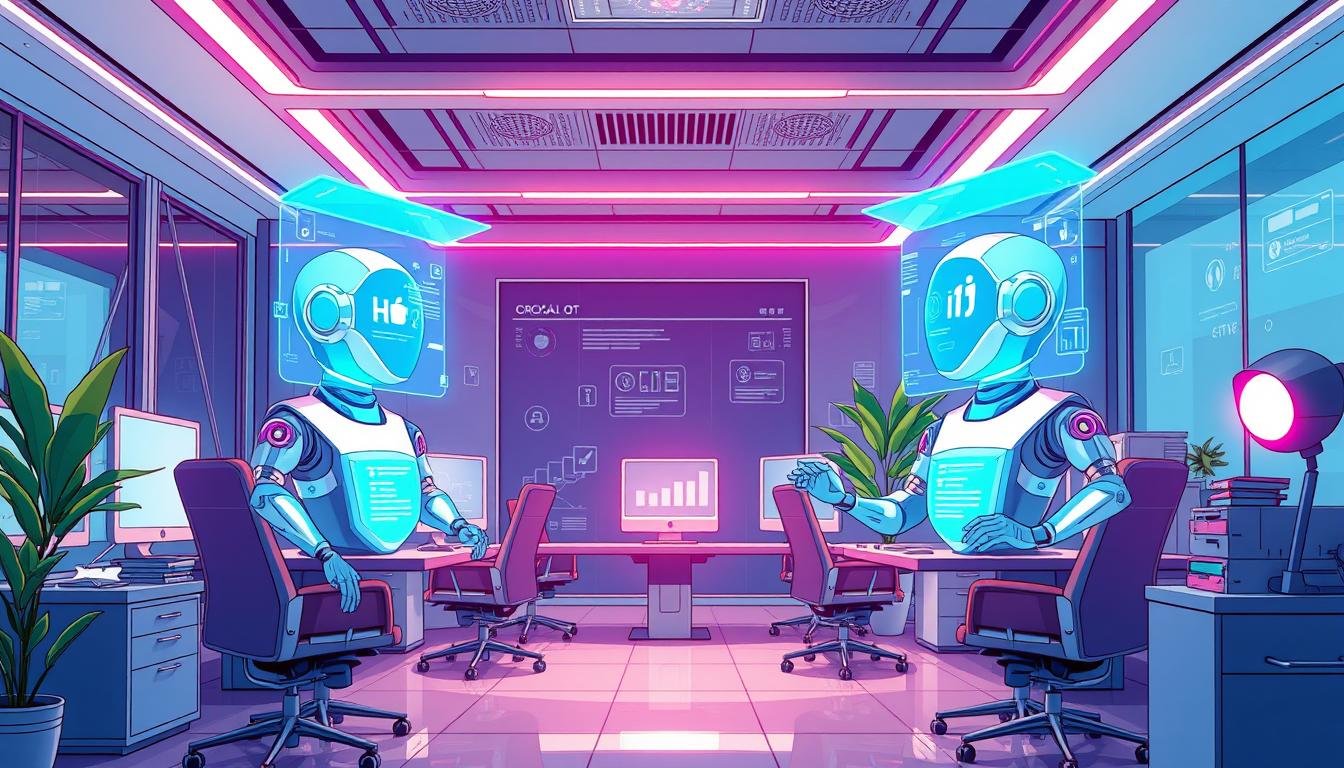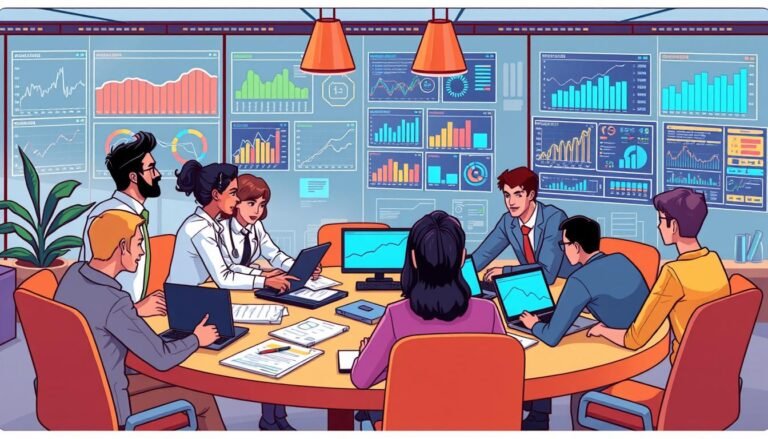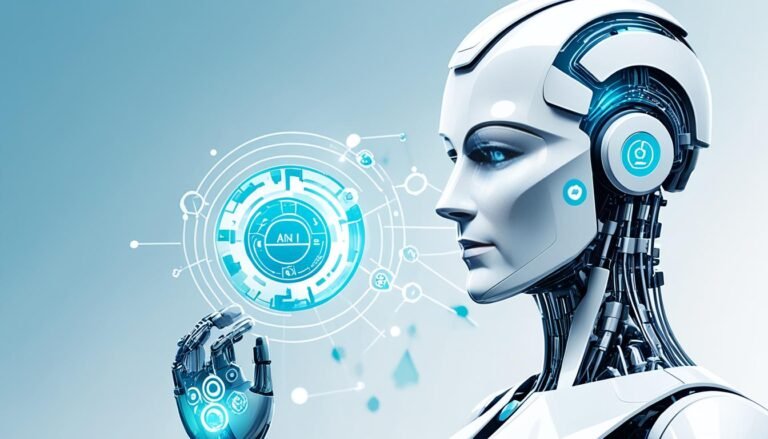The Rise of HR Chatbots and Virtual Assistants
The Human Resources world is changing fast. AI is leading the way, making big changes in how companies handle their teams. Now, chatbots and virtual assistants are key players in HR.
These smart tools are changing how we find, hire, and support employees. They’re making HR work smoother and better. They help answer questions and sort through lots of data, making them very useful.
Gartner says by 2023, 75% of HR questions will start with AI. This change is big and important. Companies are seeing big wins, like 30% better efficiency and 15% less turnover.
But it’s not just about numbers. These tools also make work better for employees. 89% of workers say they have better interactions with HR when chatbots are involved. It’s clear AI in HR is here to change the future of work.
Key Takeaways
- AI-powered HR solutions are transforming workforce management
- Chatbots and virtual assistants streamline HR processes
- 75% of HR inquiries expected to use AI platforms by 2023
- Companies report improved efficiency and lower turnover rates
- 89% of employees prefer interacting with HR chatbots
- Conversational AI enhances overall employee experience
Understanding HR Chatbots: What They Are and How They Work
HR chatbots are changing how companies handle their teams. These digital tools help with everyday tasks and offer quick help. Let’s explore what HR chatbots are and how they’re changing work.
Definition of HR Chatbots
HR chatbots are AI tools for HR tasks. They talk to employees, answer questions, and help out. They’re always ready to help, day or night, with HR needs.
Key Features of HR Chatbots
HR chatbots have features that make work better:
- They’re always there for instant help.
- They can talk in many languages to help all employees.
- They give personalized answers based on what they know about you.
- They work with other HR systems.
- They can handle lots of questions at once.
How AI Powers HR Chatbots
Artificial intelligence makes HR chatbots work. It lets them understand and learn from lots of data. AI helps chatbots:
- Understand and predict what employees might need.
- Give advice that’s just right for you.
- Deal with tough questions in a smart way.
- Keep getting better with new info.
| HR Task | Chatbot Impact | Efficiency Gain |
|---|---|---|
| Interview Scheduling | Reduced from 3 days to 3 minutes | 98% time saved |
| Employee Inquiries | 45% automated responses | 70% cost reduction |
| Onboarding Process | Improved engagement and productivity | 82% better retention |
With 62% of employees using chatbots for HR and 92% of HR teams pointing new hires to them, it’s clear chatbots are key in today’s workplace.
The Benefits of Implementing HR Chatbots
HR chatbot applications are changing how companies handle their human resources. These tools make processes smoother and improve how employees feel. They bring many benefits to the workplace.
Increased Efficiency in Recruiting
HR chatbots make hiring easier. They help sort through many applicants, a big job for 52% of recruiters. This saves a lot of time, up to 75%.
Enhanced Employee Support
These chatbots offer steady support to workers. They help new employees get settled, boosting retention by 82% and productivity by 70%. They also handle leave requests and other HR questions, making employees feel important.
Cost Savings for Organizations
Using HR chatbots can save a lot of money. For example, IBM Watson Assistant saved Telstra about AUD 10 million. It handles many tasks, freeing up HR teams to focus on big projects.
| Benefit | Impact |
|---|---|
| Recruitment Efficiency | 75% reduction in time spent on common HR tasks |
| Employee Retention | 82% improvement with strong onboarding |
| Cost Savings | Millions saved (e.g., AUD 10 million for Telstra) |
With 62% of employees liking chatbots for HR needs, it’s clear they’re key in today’s work world. As more companies use these tools, we’ll see better efficiency, happier employees, and lower costs.
Use Cases of HR Chatbots in the Workplace
HR chatbots are changing the workplace with AI support. They make work easier and better for everyone in different ways.
Streamlining the Recruitment Process
AI chatbots change hiring by doing tasks like checking applicants and setting up interviews. They make hiring faster, saving a lot of time.
Employee Onboarding Assistance
Chatbots help new employees get started. They guide them through paperwork, rules, and training. This makes starting work easier and the same for everyone.
Answering Frequently Asked Questions
HR chatbots are great at answering common questions. They give quick, right answers about pay, time off, and rules. This lets HR people do more important work.
| HR Chatbot Use Case | Benefits |
|---|---|
| Recruitment | Reduces hiring time, automates screening |
| Onboarding | Streamlines process, ensures consistency |
| FAQ Handling | Provides 24/7 support, improves response times |
Using HR chatbots helps companies work better, save money, and make employees happier. These AI tools are making HR work smarter and more focused on people.
Virtual Assistants vs. Chatbots: Key Differences
In the world of Conversational AI for HR, it’s key to know the difference between virtual assistants and chatbots. Both aim to make things more efficient. But they do it in different ways in the Digital HR assistant world.
Understanding the Distinctions
Chatbots are great for quick, simple tasks. They’re perfect for answering common questions, helping with customer service, and doing basic transactions. Virtual assistants, however, handle more complex and personalized interactions over time.
| Feature | Chatbots | Virtual Assistants |
|---|---|---|
| Interaction Type | Short-term, task-specific | Long-term, personalized |
| Capabilities | Simple queries, FAQs | Complex tasks, proactive suggestions |
| Learning Ability | Limited | Continuous learning from interactions |
When to Use Each in HR
In HR, chatbots are best for routine questions and simple tasks. They’re great for quick answers about company policies or basic processes. Virtual assistants handle more complex tasks, like performance management or career planning, thanks to their advanced AI.
Examples of Virtual Assistant Applications
Virtual assistants in HR can do many tasks, from scheduling interviews to analyzing employee feelings. They offer personalized career advice, help with onboarding, and even assist in talent planning. These AI assistants get better with each interaction, helping HR and employees more effectively.
“AI virtual assistants with machine learning capabilities can understand and analyze natural human language intricacies and nuances, providing quick and accurate resolutions that drive up customer satisfaction levels.”
Building a Successful HR Chatbot Strategy
Creating a good HR chatbot strategy needs careful planning. AI is changing how companies handle HR. To get the most from HR chatbots, focus on three main things: setting goals, choosing the right platform, and checking how well it works.
Defining Objectives and Goals
First, figure out what HR challenges your company has. Then, set clear goals for your chatbot. These could be to answer questions faster, make employees happier, or make onboarding easier.
Choosing the Right Platform
Picking the right platform is key. Think about how well it integrates, how it grows, and how easy it is for users. Choose AI HR solutions that fit your company’s needs and technology.
Monitoring and Evaluating Performance
It’s important to keep checking how your chatbot is doing. Look at things like how fast it answers, how happy users are, and how well it solves problems. Use this info to make your chatbot better over time.
| Metric | Before Chatbot | After Chatbot | Improvement |
|---|---|---|---|
| Average Response Time | 24 hours | 14.4 hours | 40% reduction |
| Employee Satisfaction | 70% | 91% | 30% increase |
| Query Resolution Rate | 60% | 85% | 41.7% increase |
By following these steps, companies can make a strong HR chatbot strategy. This will make things more efficient and better for employees. Start with a test, look at the results, and work with vendors to meet legal rules.
The Role of Natural Language Processing in HR Chatbots
Natural language processing for HR is changing how companies talk to employees and job seekers. This tech makes communication better and more personal.
What is Natural Language Processing?
Natural language processing (NLP) is a part of artificial intelligence. It lets computers understand and create human language. In HR, NLP helps chatbots have real conversations, answer questions, and help employees and job seekers.
Applications of NLP in HR Chatbots
HR chatbots use NLP in many ways:
- Recruitment: Chatbots talk to job seekers, answer their questions, and check candidates.
- Onboarding: 92% of HR teams use chatbots to help new employees start.
- Employee support: 62% of employees use chatbots for HR needs, like pay stubs and benefits.
Challenges and Limitations of NLP
NLP has made big progress, but it still has challenges in HR:
| Challenge | Impact |
|---|---|
| Understanding context | May lead to misinterpretation of employee queries |
| Handling complex inquiries | Limits ability to address nuanced HR issues |
| Maintaining data privacy | Raises concerns about sensitive employee information |
Despite these challenges, NLP in HR chatbots offers clear benefits. Companies have saved 12,000 work hours with digital workers. This shows NLP’s potential to change HR processes.
Common Challenges in Implementing HR Chatbots
AI-driven HR support offers exciting possibilities. Yet, organizations face challenges when introducing chatbots. Let’s look at the main hurdles and possible solutions.
Resistance to Change from Employees
Many workers prefer talking to humans and might resist chatbots. To overcome this, companies should focus on improving employee experience. Teaching staff about chatbot benefits and starting with simple tasks can help.
Integration with Existing HR Systems
Integrating chatbots with current HR systems can be tricky. A weak data infrastructure can limit functionality. Companies should invest in strong integration plans for smooth operations.
Ensuring Data Security and Privacy
Keeping sensitive employee data safe is key. HR leaders must set up strict security measures and follow data protection laws. This includes creating policies for chatbot conversations.
Despite these challenges, HR chatbots offer big benefits. They can handle millions of conversations, boosting knowledge and efficiency. At Airbus, chatbot Bessie answered 74% of candidate questions, showing its value in recruitment.
| Challenge | Solution |
|---|---|
| Employee resistance | Education and gradual implementation |
| System integration | Invest in robust integration strategies |
| Data security | Establish strict protocols and compliance measures |
By tackling these challenges, organizations can fully benefit from AI-driven HR support. This leads to better efficiency and improved employee experiences.
Future Trends in HR Chatbots and Virtual Assistants
The future of HR is changing with AI. Exciting changes in intelligent HR automation are making the workplace better.
Advancements in Machine Learning
Machine learning is changing HR chatbots. They’re getting smarter, giving better insights and talking more naturally. By 2025, 82% of companies will use AI in HR. This will cut hiring time by 45% and save $8 billion a year.
Personalization and Customization
HR chatbots are getting better at personalizing experiences. They learn what each employee needs, offering support and advice. This makes employees more engaged, boosting earnings by 147%.
Integrating with Remote Work Technologies
HR chatbots are adapting to remote work. They work with virtual tools, time tracking, and project management. This keeps teams productive and connected, even when they’re apart.
| HR Chatbot Feature | Impact |
|---|---|
| 24/7 Accessibility | Crucial for global organizations |
| Automated Inquiries | 60% automation saves 30% in costs |
| AI-driven Assessments | 35% increase in employee retention |
| Onboarding Assistance | 31% increase in satisfaction scores |
The future of HR chatbots and virtual assistants looks bright. With AI and machine learning, they’ll keep making HR better. They’ll make it more efficient, personal, and fit for the changing work world.
Real-World Success Stories of HR Chatbots
HR chatbots have changed how we work in many fields. Let’s look at some amazing examples that show how these digital helpers can make a big difference.
Case Study: Enhancing Employee Experience
Adobe Sensei used chatbots to give personalized learning tips. This led to a 40% increase in employee happiness and a 25% drop in people leaving their jobs. This story shows how AI chatbots can make employees more engaged and happy.
Case Study: Speeding Up the Hiring Process
IBM used Watson Recruitment to make hiring faster. They cut the time it took to fill a job from 30 days to just 10. This shows how chatbots can make hiring quicker, saving time for everyone involved.
Key Takeaways from Successful Implementations
Many companies have seen great results from using HR chatbots. Unilever cut HR costs by 40% with AI chatbots for simple questions. Citigroup used AI to predict who might leave, reducing turnover by 20%.
| Company | HR Chatbot Application | Result |
|---|---|---|
| Unilever | U-Ask | 40% reduction in HR service costs |
| IBM | Watson Assistant | Real-time HR information access |
| Xerox | HR Chatbot | 24/7 HR information access |
| Starbucks | Employee Engagement Chatbot | Improved employee satisfaction and retention |
These stories show how HR chatbots can change the game for employees and make HR work easier in many industries.
The Ethical Considerations of Using HR Chatbots
AI-driven HR support is becoming more common. But, it raises big ethical questions. These tools are very helpful, but we must think about their impact carefully.
Transparency in Communication
Companies using HR chatbots need to be clear with their employees. They should say when AI is helping with HR tasks. This honesty builds trust and avoids confusion.
Addressing Bias and Fairness
AI can carry biases from old data. To be fair, we need to check AI HR systems often. Companies like IBM help reduce bias in AI, making sure everyone is treated equally.
Effect on Employee Job Security
Chatbots make some worry about losing their jobs. It’s important for companies to explain how AI will work with, not replace, HR staff. This way, everyone feels valued and works well together.
“64% of individuals trust robots more than their managers for advice, highlighting the growing acceptance of AI in the workplace.”
AI brings many benefits to HR, but we must use it ethically. By being open, fair, and clear about jobs, we can use AI wisely. This keeps trust and ethics at the heart of our work.
Tips for Choosing the Right HR Chatbot Solution
Choosing the right HR chatbot solution is key for your business. These digital tools help streamline operations and improve employee experiences. They are crucial for modern businesses.
Evaluating Your Organization’s Needs
First, think about your company’s size, industry, and current HR processes. Identify the areas you want to improve with HR chatbots. Do you need better recruitment, more employee support, or to automate tasks?
Comparing Features and Pricing
When looking at HR chatbot solutions, focus on what you need. Look for platforms that offer:
- Multilingual support
- Integration with existing tools
- Scalability for growing user bases
- Strong AI for natural language processing
Pricing varies, so consider your budget and expected benefits. Some HR chatbots can boost productivity by up to 99%, making them worth the cost.
Considerations for User Experience
The success of your HR chatbot depends on how well employees use it. Choose a solution with an easy-to-use interface. Look for chatbots that offer:
- 24/7 availability
- Personalized interactions
- Quick response times
- Seamless device compatibility
A good HR chatbot can greatly enhance the candidate experience. It can also increase application rates to 90%.
“Culture may be the biggest determinant of chatbot success.” – Ed Barry, Gallagher
By evaluating your needs, comparing features, and focusing on user experience, you can find the right HR chatbot. It will help make your organization more efficient and improve employee satisfaction.
The Future of HR: What Lies Ahead with Chatbots
The HR world is changing fast, thanks to AI. AI and humans working together will change the industry a lot. Let’s see what’s coming for HR and chatbots.
Predictions on AI and HR Collaboration
AI is making HR smarter and more strategic. A study in the International Journal for Multidisciplinary Research found AI helped a healthcare company cut turnover by 15% in two years. This shows AI’s strength in solving workforce problems.
The Evolving Role of HR Professionals
HR pros are now focusing on big ideas, not just routine tasks. Peter Cappelli’s article “Will AI Change How We Manage People?” points out the importance of AI and human touch. This change lets HR teams work on creative projects and keeping employees happy.
Preparing for Tomorrow’s Workforce
The next workforce will need tech skills and human touch. AI is making HR more personal, from hiring to retirement. For example, Culture Amp is changing how we talk to employees. HR must keep up with these changes and make sure AI is fair and open.
Source Links
- The Role of Chatbots and Virtual Assistants in HR
- The Rise of AI Chatbots in Human Resources
- The Rise of Virtual HR Assistants and Chatbots
- HR Chatbots: Benefits, Use Cases, Statistics [2024]
- HR chatbots: A guide for HR professionals – TG
- HR Chatbots: Benefits, Use Cases, and Examples for 2024
- How chatbots improve human resource operations | IBM
- Chatbots In HR 2024: Benefits, Use Cases, Examples – Springs
- What is an HR Chatbot? Use Cases and Benefits
- HR Chatbots – Benefits & Use Cases – Yellow.ai
- Chatbots vs Virtual Assistants: What are Differences in 2024
- Chatbots vs. Virtual Assistants – What’s the Difference? – Yellow.ai
- How HR Chatbots Can Improve HR Processes (Includes Company Examples)
- Implementing chatbots and virtual assistants in HR services for employee engagement
- Blog: How AI Chatbots are Used in Human Resources
- HR Chatbots: The AI Revolution in Human Resources
- How HR Is Using Virtual Chat and Chatbots
- Benefits and challenges of using chatbots in HR | TechTarget
- From Chatbots to Virtual Assistants: The Future of HR Support
- Chatbots and Virtual Assistants: Transforming HR Communication
- Embracing the Future: HR Technology Trends to Watch in 2024
- AI’s Transformative Influence on HR Excellence: Real-Life Success Stories
- The AI Revolution: Chatbots in HR
- Data Privacy and Ethical Considerations in AI-Driven Recruitment
- A PeopleOps Pro’s Guide to Ethical Use of AI in HR – SSR
- How to Choose the Right HR Chatbot For Your Organization
- 10-Point Checklist to Choose the Right HR virtual assistant
- Your HR team needs to communicate more effectively. Which chatbot service should you use?
- The Future of HR Tech: Innovations Transforming Human Resources | Candor
- AI in Talent Acquisition and HR: Shaping the Future of Workforce Intelligence








